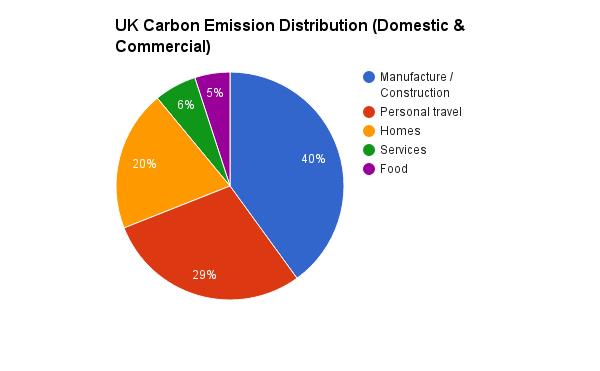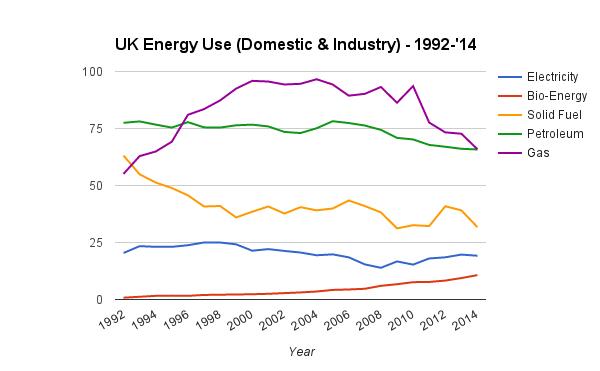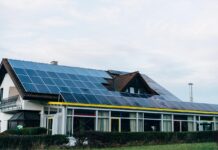 Climate change, carbon emissions and energy efficiency are all key topics in the UK – and especially for businesses, where the impact will be biggest. The UK currently has a target to reduce emissions by 29% by the end of next year, with an 80% reduction target by 2050.
Climate change, carbon emissions and energy efficiency are all key topics in the UK – and especially for businesses, where the impact will be biggest. The UK currently has a target to reduce emissions by 29% by the end of next year, with an 80% reduction target by 2050.
With these targets in mind, there’s a lot of onus on both energy companies and big businesses to improve efficiency and reduce usage – which will cut both the environmental and financial impacts. While electricity doesn’t account for the highest usage of energy, its usage has increased over the last 45 years and reliance on gas and coal remains extremely high.
How Does Renewable & Efficient Connect To Business?
Manufacturing and construction (which breaks down to a number of different commercial sectors; see the source link below the chart) accounts for 40% of all UK carbon emissions. Any changes in this area, particularly when scaled up, will have a huge impact on our overall energy efficiency and usage.
Source: James Murdoch – The Rough Guide To Saving Energy
Due to the overall energy usage in commercial sectors, the usage of different energy types and sources is much higher across the board, and this is particularly noticeable with electricity usage. With this in mind, it’s changes in commercial sectors that are going to make the biggest impact on energy usage reductions.
Source: Department of Energy & Climate Chance – Energy Consumption in the UK
Why Does Electricity Matter So Much?
Out of all of the UK’s energy usage, the breakdown of sources does put electricity fairly low on the list; we do also know that gas and solid fuels are a source of electricity generation, however. That said, its usage over time has remained relatively unchanged (and has, from a commercial perspective, increased) – all while sources like petroleum and gas have reduced, and bio-energy has risen. This makes electricity the ideal candidate for improvements in energy usage; it’s achievable at even a small business level and doesn’t necessarily rely on investment or buy-in at a higher level, such as energy companies or government bodies.
Source: Department of Energy & Climate Chance – Energy Consumption Industrial Factsheet
How Can Usage Be Reduced?
While it’s a valid point often made that if the sources of electricity generation are improved and rely more on renewable technology, then this alone will make an impact on carbon footprints and costs to businesses. However, the UK isn’t at this point yet; we currently get three-quarters of our electricity from coal and gas plants, and overall usage in industry has actually increased over the last 45 years.
There are a number of ways business can approach energy reduction which, particularly when scaled up across whole offices or multiple premises, can make a huge difference to both cost and carbon footprint.
Automated Heating & Cooling Systems
There are a number of ways of automating vital systems in commercial and industrial buildings, particularly where heating and cooling are involved, as these are accountable for a significant amount of energy consumption.
Sustainable energy expert Professor David Mackay has talked a lot about what he calls ‘the myth of every little helps’, in which he points to businesses making bigger changes at scale to have the most significant impact; he argues that “we’re getting to a point [where] our staff have very little effect on our overall energy consumption”.
The argument is that, rather than reminding employees to constantly turn off lights or power down air con equipment, these systems should be automated. These can include timers, off-site remote control (ie. ‘smart systems’) and motion sensor activation, amongst others.
Energy Efficient Lighting
It sounds like a little bit of a cliché, but energy efficient lighting can make a really noticeable impact on both electricity usage and running costs; up to 40% of a building’s electricity usage can be accounted for directly from lighting.
Switching to LED lighting can reduce energy usage by around 80%, according to the Carbon Trust, but it’s important to make sure that your building’s specific needs are considered so that it’s implemented in the best possible way. The Carbon Trust recommend working closely with a specialist to really define what’s needed and the best way to reduce costs using LED lighting; UK specialist supplier LED Ecolite can break down as far as how the lighting works with businesses to ensure that the most appropriate solutions are used across the company.
Major Changes – Aim High
The big changes, particularly when scaled up, are going to make the biggest impact; while small aspects will certainly contribute, making the bigger changes the priority will be demonstrably more effective. This includes overhauling HVAC and lighting systems (such as investing in new systems) and implemented automation and off-site control for powered systems.
Find a Home-Based Business to Start-Up >>> Hundreds of Business Listings.



















































